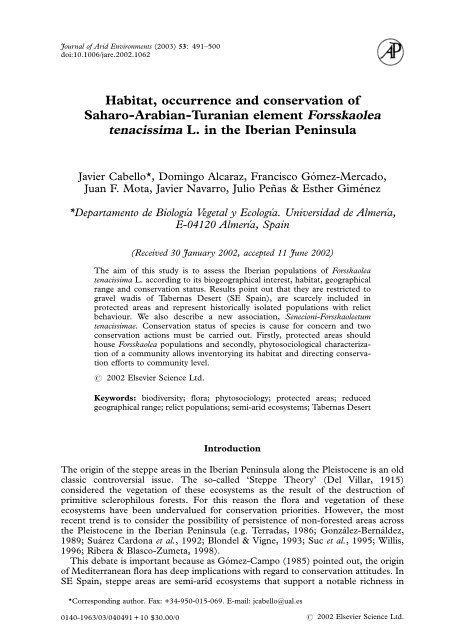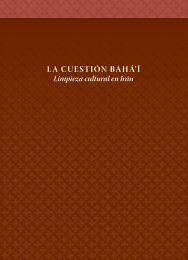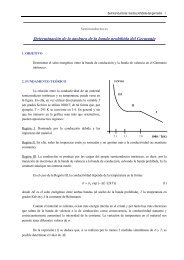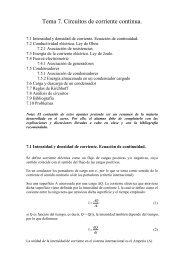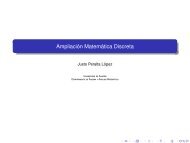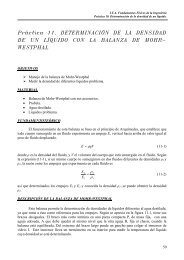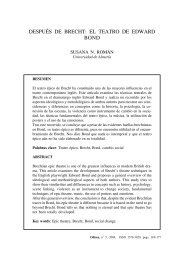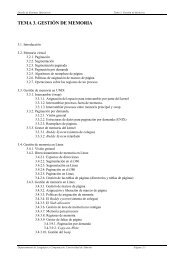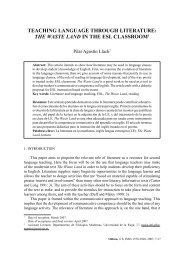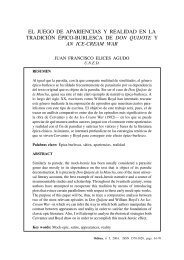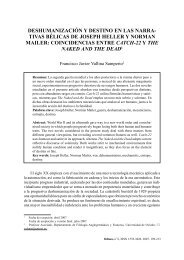Habitat, occurrence and conservation of Saharo-Arabian-Turanian ...
Habitat, occurrence and conservation of Saharo-Arabian-Turanian ...
Habitat, occurrence and conservation of Saharo-Arabian-Turanian ...
You also want an ePaper? Increase the reach of your titles
YUMPU automatically turns print PDFs into web optimized ePapers that Google loves.
Journal <strong>of</strong> Arid Environments (2003) 53: 491–500<br />
doi:10.1006/jare.2002.1062<br />
<strong>Habitat</strong>, <strong>occurrence</strong> <strong>and</strong> <strong>conservation</strong> <strong>of</strong><br />
<strong>Saharo</strong>-<strong>Arabian</strong>-<strong>Turanian</strong> element Forsskaolea<br />
tenacissima L. in the Iberian Peninsula<br />
Javier Cabello*, Domingo Alcaraz, Francisco Gómez-Mercado,<br />
Juan F. Mota, Javier Navarro, Julio Peñas & Esther Giménez<br />
*Departamento de Biología Vegetal y Ecología. Universidad de Almería,<br />
E-04120 Almería, Spain<br />
(Received 30 January 2002, accepted 11 June 2002)<br />
The aim <strong>of</strong> this study is to assess the Iberian populations <strong>of</strong> Forsskaolea<br />
tenacissima L. according to its biogeographical interest, habitat, geographical<br />
range <strong>and</strong> <strong>conservation</strong> status. Results point out that they are restricted to<br />
gravel wadis <strong>of</strong> Tabernas Desert (SE Spain), are scarcely included in<br />
protected areas <strong>and</strong> represent historically isolated populations with relict<br />
behaviour. We also describe a new association, Senecioni-Forsskaoleetum<br />
tenacissimae. Conservation status <strong>of</strong> species is cause for concern <strong>and</strong> two<br />
<strong>conservation</strong> actions must be carried out. Firstly, protected areas should<br />
house Forsskaolea populations <strong>and</strong> secondly, phytosociological characterization<br />
<strong>of</strong> a community allows inventorying its habitat <strong>and</strong> directing <strong>conservation</strong><br />
efforts to community level.<br />
# 2002 Elsevier Science Ltd.<br />
Keywords: biodiversity; flora; phytosociology; protected areas; reduced<br />
geographical range; relict populations; semi-arid ecosystems; Tabernas Desert<br />
Introduction<br />
The origin <strong>of</strong> the steppe areas in the Iberian Peninsula along the Pleistocene is an old<br />
classic controversial issue. The so-called ‘Steppe Theory’ (Del Villar, 1915)<br />
considered the vegetation <strong>of</strong> these ecosystems as the result <strong>of</strong> the destruction <strong>of</strong><br />
primitive sclerophilous forests. For this reason the flora <strong>and</strong> vegetation <strong>of</strong> these<br />
ecosystems have been undervalued for <strong>conservation</strong> priorities. However, the most<br />
recent trend is to consider the possibility <strong>of</strong> persistence <strong>of</strong> non-forested areas across<br />
the Pleistocene in the Iberian Peninsula (e.g. Terradas, 1986; González-Bernáldez,<br />
1989; Suárez Cardona et al., 1992; Blondel & Vigne, 1993; Suc et al., 1995; Willis,<br />
1996; Ribera & Blasco-Zumeta, 1998).<br />
This debate is important because as Gómez-Campo (1985) pointed out, the origin<br />
<strong>of</strong> Mediterranean flora has deep implications with regard to <strong>conservation</strong> attitudes. In<br />
SE Spain, steppe areas are semi-arid ecosystems that support a notable richness in<br />
*Corresponding author. Fax: +34-950-015-069. E-mail: jcabello@ual.es<br />
0140-1963/03/040491 + 10 $30.00/0 # 2002 Elsevier Science Ltd.
492 J. CABELLO ET AL.<br />
species, with a large number <strong>of</strong> endemisms <strong>and</strong> Mesogean elements (Peinado et al.,<br />
1992; Cabello, 1997). One <strong>of</strong> the latest is the <strong>Saharo</strong>-<strong>Arabian</strong>–<strong>Turanian</strong> element<br />
Forsskaolea tenacissima L. (Danin & Orshan, 1999) extending into the Mediterranean<br />
region (Fig. 1). This plant has a disperse geographical distribution along Palestine<br />
(Zohary, 1966; Evenari et al., 1971), Egypt (Ayyard & Ghabbour, 1986), North Africa<br />
<strong>and</strong> Sahara Desert (Ozenda, 1983; Le Houérou, 1986, 1995) <strong>and</strong> SE Spain (Sagredo,<br />
1987; Paiva, 1993).<br />
Literature (Sagredo, 1987; Paiva, 1993; Lorite et al., 1998), suggests that the<br />
geographical range in Europe <strong>of</strong> this species is restricted to a few localities in SE<br />
Iberian Peninsula, where the regional climate is notably semi-arid both due to the<br />
rainfall shadow effect <strong>of</strong> the main Betic ranges <strong>and</strong> its proximity to northern Africa<br />
(Geiger, 1973).<br />
Regarding the biogeographical <strong>and</strong> ecological interest <strong>of</strong> this species in a European<br />
biodiversity scenario, the aim <strong>of</strong> this study is to assess the populations <strong>of</strong> F. tenacissima<br />
L. in the Iberian Peninsula according to its habitat, geographical range <strong>and</strong><br />
<strong>conservation</strong> status. Taking into account that <strong>conservation</strong> becomes more logical<br />
when directed to syntaxa or to ecosystems than to a single species (Gómez-Campo,<br />
1985), we studied the habitat <strong>of</strong> the species to enhance its role as a <strong>conservation</strong><br />
target.<br />
Material <strong>and</strong> methods<br />
The study was based on collections, literature <strong>and</strong> fieldwork carried out during<br />
1999–2000. To assess the habitat <strong>of</strong> the species we studied biotope, community<br />
<strong>and</strong> bioclimatic traits. At the community level we studied the phytosociological<br />
behaviour <strong>of</strong> the species according to the Zurich–Montpellier school methods<br />
(Braun-Blanquet, 1979; Gehú & Rivas-Martínez, 1981). Taxa nomenclature first<br />
follows Castroviejo et al. (1986–2001) <strong>and</strong> Tutin et al. (1964–1980) for those<br />
taxa non-cited in the former reference. The syntaxonomical scheme follows<br />
Rivas-Martínez et al. (2001). For the description <strong>of</strong> this new association we<br />
used International Code <strong>of</strong> Phytosociological Nomenclature (Weber et al., 2000).<br />
For bioclimatic characterization <strong>of</strong> the populations, we considered bioclimatic<br />
It index proposed by Rivas-Martínez & Loidi (1999). Conservation<br />
status was studied to assess the <strong>occurrence</strong> <strong>of</strong> populations in protected areas<br />
(Fig. 2).<br />
Results<br />
Geographical range<br />
Iberian populations are restricted to gravel banks <strong>of</strong> some wadis <strong>of</strong> Tabernas Desert<br />
(Fig. 2): Rambla de Espinaza (Losa & Rivas Goday, 1968), Rambla de San Indalecio,<br />
Rambla de Gérgal (Kunkel, 1987), Rambla de Tabernas (Kunkel, 1987; Sagredo,<br />
1987), Rambla de los Yesos (Lorite et al., 1998). As a result <strong>of</strong> fieldwork we confirmed<br />
all citations, <strong>and</strong> we added new localities: Rambla de San Telmo (Herbario de la<br />
Universidad de Almería, 1317) y Rambla de Los Alhamillos-Gérgal (Herbario de la<br />
Universidad de Almería, 1318).<br />
<strong>Habitat</strong><br />
Iberian populations inhabit on gravel banks. This biotope emerges naturally in<br />
wadis, <strong>and</strong> in man-made terraces in flood plains <strong>of</strong> Tabernas Desert. Considering
ASSESSMENT OF IBERIAN POPULATIONS OF FORSSKAOLEA TENACISSIMA 493<br />
Figure 1. Geographical range <strong>of</strong> Forsskaolea tenacissima L. in the Mediterranean Basin <strong>and</strong> bioclimatic features <strong>of</strong> its area.
494 J. CABELLO ET AL.<br />
Sierra Nevada<br />
Natural Park<br />
Tabernas<br />
Desert<br />
Tabernas<br />
Natural Park<br />
2<br />
1 3 6 5<br />
4 7<br />
8<br />
9<br />
10<br />
ATLANTIC<br />
OCEAN<br />
Sierra Alhamilla<br />
Natural Park<br />
N<br />
Iberian<br />
Peninsula<br />
Morocco<br />
Almería<br />
MEDITER-<br />
RANEAN<br />
SEA<br />
Algeria<br />
MEDITERRANEAN<br />
SEA<br />
0 10<br />
km<br />
Figure 2. Location <strong>of</strong> Forsskaolea tenacissima L. populations in the Iberian Peninsula. (1)<br />
Rambla de Los Yesos; (2) Rambla de Los Alhamillos-Gérgal; (3,4) Rambla de Gérgal; (5–7)<br />
Rambla de Tabernas; (8) Rambla Espinaza; (9) Rambla de San Indalecio; (10) Rambla de San<br />
Telmo.<br />
the species composition recorded in the relevés, the community <strong>of</strong> F. tenacissima<br />
(Table 1) belongs to Glaucion flavi Alliance (Andryaletalia ragusinae Order, Thlaspietea<br />
rotundifolii Class), which represent the vegetation <strong>of</strong> gravel <strong>and</strong> pebbles <strong>of</strong> riverbanks<br />
in the Mediterranean Region. The community always appears in the early stages<br />
<strong>of</strong> succession, <strong>and</strong> when the substratum becomes steadier, perennial communities <strong>of</strong><br />
Pegano-Salsoletea Class displace it. Due to this, on the bank <strong>of</strong> the wadis, where<br />
the disturbances more frequently occur in a natural way, the community is more<br />
constant.<br />
Forsskaolea tenacissima populations appear from 100 to 500 m <strong>of</strong> altitude. The<br />
aridity <strong>of</strong> its distribution area is obvious since the annual rainfall average is lower than<br />
300 mm, <strong>and</strong> recent studies <strong>of</strong> Tabernas Desert reveal that 34% <strong>of</strong> the months it is<br />
lower than 10 mm (Lázaro et al., 2001). According to the bioclimatological indices<br />
from Rivas-Martínez & Loidi (1999), the geographical range falls in the Mediterranean<br />
desertic–oceanic bioclime, thermo-Mediterranean arid <strong>and</strong> semi-arid belts<br />
(Table 2).<br />
Conservation status<br />
The area <strong>of</strong> occupancy is extremely reduced, since we only found seven main<br />
populations (Table 2), which are scarcely included in protected areas. Only the<br />
Rambla de Tabernas population is partially embraced by the Tabernas Desert Natural
ASSESSMENT OF IBERIAN POPULATIONS OF FORSSKAOLEA TENACISSIMA 495<br />
Table 1. Senecioni flavi–Forsskaoleetum tenacissimae ass. nov.<br />
1 2 3 4 5 6 7 8 9 10<br />
Altitude (m) 228 198 300 300 325 325 325 255 100 300<br />
Exposure E F E E E E E F F SW<br />
Slope (1) 40 F 25 40 20 15 15 F F 20<br />
Area (m 2 ) 25 25 25 30 25 25 20 25 20 20<br />
Association <strong>and</strong> higher<br />
syntaxa features<br />
Forsskaolea tenacissima 2 2 2 2 2 2 + 2 2 2<br />
Senecio flavus . 1 + 1 1 + 2 . 1 2<br />
Andryala ragusina 2 2 1 2 1 2 . 1 1 .<br />
Ononis talaverae + . . + . . . + + .<br />
Scrophularia canina + . . . . . . 1 . .<br />
Lactuca viminea . . . . . . . + . .<br />
Accompanying species<br />
Launaea arborescens 2 + + + 1 + + 1 + 1<br />
Reseda lanceolata + . 1 1 + + 1 . 1 1<br />
Glaucium flavum . . 1 1 + 1 + . + +<br />
Genista umbellata . + 1 . . + + . + +<br />
Diplotaxis harra subsp. 1 . . + + + 1 . . 1<br />
lagascana<br />
Anthyllis cytisoides + . . + . + . 1 . +<br />
Dittrichia viscosa . . + . 1 1 . . . +<br />
Dorycnium pentaphyllum + . . . 1 . . 1 . .<br />
Limonium insigne . . + . + . . . . .<br />
Anthyllis terniflora . . . . + . . 1 . .<br />
Lav<strong>and</strong>ula multifida . . . . + . . 1 . .<br />
Fagonia cretica . . . . . . . . + +<br />
In addition: Asphodelus albus +, Atriplex halimus +, Sonchus tenerrimus +, Launaea fragilis 1en1.Eryngium<br />
campestre +en2.Salsola kali +en4.Centaurea melitensis +, Salsola genistoides + en 5. Bituminaria<br />
bituminosa +, Atriplex glauca +en6.Piptatherum miliaceum 1, Zygophyllum fabago +, Corrigiola telephiifolia<br />
+, Launaea lanifera +, Retama sphaerocarpa +, Artemisia barrelieri +, Frankenia corymbosa +, Thymelaea<br />
hirsuta +en8.Glaucium corniculatum +, Euzomodendron bourgaeanum +, Anabasis articulata +en9.<br />
Herniaria fontanesii subsp. almeriana + en 10.<br />
Localities (all <strong>of</strong> them in Almería Province, Spain): 1 Rambla de Tabernas WF4795; 2. Rambla de<br />
Tabernas WF4793; 3–7, Rambla de Tabernas WF4895; 8, Rambla de Gérgal WF4093; 9, Rambla de San<br />
Indalecio WF5185; 10, Rambla de Espinaza WF5389.<br />
Park <strong>and</strong> the Rambla de Los Yesos population is included in the Sierra Nevada<br />
Natural Park. The rest <strong>of</strong> them are outside any protected area (Fig. 2).<br />
Discussion<br />
The ecological behaviour described above for Iberian populations <strong>of</strong> F. tenacissimae<br />
agree with other world areas. Gravel banks <strong>of</strong> Tabernas wadis represent the same<br />
edaphic conditions described for other areas like the Negev Desert (Evenari et al.,<br />
1971) or the Sahara Desert (Maire, 1952–1977). The Tabernas Desert with<br />
Mediterranean hyperdesertic <strong>and</strong> Mediterranean desertic–oceanic bioclimes (according<br />
to Rivas-Martínez & Loidi, 1999), is the only European area with similar<br />
bioclimatic conditions to semi-arid areas <strong>of</strong> North Africa <strong>and</strong> West Asia (Fig. 1).
Table 2. Location, bioclimatic traits <strong>and</strong> presence in protected areas <strong>of</strong> Iberian populations <strong>of</strong> Forsskaolea tenacissima L.<br />
Localities Population Geographic<br />
coordinates (UTM)<br />
Bioclimatic traits<br />
Alt* (m) It w Pp z (mm)<br />
Protected area<br />
Rambla de Los Yesos 1 30SWF3199 500 340 340 Sierra Nevada Natural Park<br />
Rambla de Los<br />
2 30SWF4199 300 300 290 F<br />
Alhamillos-Gérgal<br />
Rambla de Gérgal 3<br />
4<br />
Rambla de Tabernas 5<br />
6<br />
7<br />
30SWF4093<br />
30SWF4092<br />
30SWF4895<br />
30SWF4795<br />
30SWF4793<br />
220<br />
260<br />
250<br />
190<br />
200<br />
295<br />
300<br />
300<br />
290<br />
290<br />
271<br />
280<br />
279<br />
263<br />
279<br />
F<br />
Tabernas Desert Natural Park<br />
(Partially)<br />
Rambla de Espinaza 8 30SWF5389 250 300 279 F<br />
Rambla de San<br />
9 30SWF5086 150 280 252 F<br />
Indalecio<br />
Rambla de San Telmo 10 30SWF4576 100 275 240 F<br />
*Altitude.<br />
w It: Thermicity index: Sum, multiplied by 10, <strong>of</strong> the annual mean temperatures (T), mean maximum temperature <strong>of</strong> the coldest month (M) <strong>and</strong> mean minimum<br />
temperatures <strong>of</strong> the coldest month (m), It = 10(T+M+m) (Rivas-Martínez & Loidi, 1999).<br />
z Precipitation.<br />
496 J. CABELLO ET AL.
ASSESSMENT OF IBERIAN POPULATIONS OF FORSSKAOLEA TENACISSIMA 497<br />
Iberian F. tenacissima communities present biogeographical <strong>and</strong> floristic traits that allow<br />
us to propose a new association. Thermo- <strong>and</strong> meso-Mediterranenan shrubl<strong>and</strong>s <strong>of</strong> stony<br />
areas <strong>and</strong> dry rivers distributed throughout the East Iberian Peninsula <strong>and</strong> Balearic<br />
Isl<strong>and</strong>s belongs to Andryaletum ragusinae association (G. flavi Alliance), led by Andryala<br />
ragusina L. <strong>and</strong> Mercurialis tomentosa L. (Bolós, 1967). However, the community <strong>of</strong> the<br />
Tabernas Desert wadis is led by both F. tenacissima <strong>and</strong> Senecio flavus (Decne.) Sch. Bip.<br />
Thefirstoneisa<strong>Saharo</strong>-<strong>Arabian</strong>–<strong>Turanian</strong>element<strong>and</strong>thesecondoneisaWest<br />
Mediterranean element with restricted distribution in the Iberian Peninsula. From a<br />
biogeographical st<strong>and</strong>point <strong>and</strong> at regional scale, both elements are differential taxa from<br />
the Occidental-Almerian District with regard to the rest <strong>of</strong> the Almerian SectorF<br />
Murcian–Almerian Province (Peinado et al., 1992; Mota et al., 1997).<br />
Because <strong>of</strong> this floristic feature <strong>and</strong> the frequent presence in the relevés <strong>of</strong><br />
Ononis talaverae, another restricted Iberian–North-African element (Devesa, 2000),<br />
we described a new endemic association for the Occidental-Almerian District<br />
(Almerian Sector, Murcian–Almerian Province) (Table 1, syntypus rel. 4). The<br />
presence in the relevés <strong>of</strong>Salsolo-Peganion elements as accompanying species is due to<br />
the pioneer perennial vegetation which is the spatial <strong>and</strong> successional contiguous<br />
vegetation.<br />
Preservation <strong>of</strong> isolated populations <strong>and</strong> capturing the geographic range <strong>of</strong> species is<br />
widely dem<strong>and</strong>ed in Conservation Biology (Rojas, 1992; Sutherl<strong>and</strong>, 2000; Scott<br />
et al., 2001). Reasons for this are the possible effects on biodiversity elements caused<br />
by global <strong>and</strong> regional climate changes (Peters & Lovejoy, 1992), the need to maintain<br />
genetic diversity (Jones et al., 2001), <strong>and</strong> the fact that stochastic events may threaten<br />
resources restricted to just one area (Pressey et al., 1993, 1994). Moreover, Lesica &<br />
Allendorf (1995) suggest that populations on the periphery <strong>of</strong> their ranges may be the<br />
most genetically variable <strong>and</strong> thus evolutionarily valuable if they are confronted with<br />
contracting ranges, <strong>and</strong> so may be less vulnerable to anthropogenic or natural<br />
changes.<br />
The main objective <strong>of</strong> this work was to assess F. tenacissima as a <strong>conservation</strong><br />
flora priority in the European context. Taking into account that the last connection<br />
between Africa <strong>and</strong> Europe was 3 millions years ago (Sanz de Galdeano, 1997),<br />
the Tabernas Desert populations represent historically (at geological-evolutionary<br />
time scale) isolated populations from the rest <strong>of</strong> African, <strong>Arabian</strong> <strong>and</strong> <strong>Turanian</strong><br />
populations, <strong>and</strong> hence, as we showed above, they are interesting from biodiversity<br />
point <strong>of</strong> view. In addition, its <strong>occurrence</strong> in the SE Iberian Peninsula has a<br />
great importance from a biogeographical approach. This is due to two facts: on<br />
the one h<strong>and</strong>, it reflects both the floristic interchange between SE Iberian Peninsula<br />
<strong>and</strong> northern Africa <strong>and</strong> western Asia during the Messinian desiccation <strong>of</strong><br />
the Mediterranean Sea (Suárez et al., 1992), <strong>and</strong>, on the other one, it stresses<br />
the hypothesis <strong>of</strong> considering the presence <strong>of</strong> steppe habitats along the Pleistocene in<br />
the Iberian peninsula. Some authors suggest that those areas, less affected by glaciers,<br />
constituted refuges for xerophytic elements during the Quaternary Period (Bolós,<br />
1951; Blanca, 1991; Cabello, 1997).<br />
Whereas in other areas such as Israel, it is a common taxon (The Hebrew University<br />
Herbarium, 2000) in the Iberian area it is rare. Predictive distribution based on<br />
bioclimatic <strong>and</strong> ecological conditions suggest that the species should appear in most <strong>of</strong><br />
the Murcian–Almerian Province. However, as a result <strong>of</strong> the fieldwork, even within the<br />
Tabernas Desert, we have observed just a few populations. Two reasons for such a<br />
restricted area <strong>of</strong> occupancy might be either a low dispersal capacity <strong>of</strong> F. tenacissima<br />
or the fact that Tabernas basin materials are mainly Tortonian marine marls, <strong>and</strong><br />
hence many wadis have high salinity conditions. In addition, peripheral populations <strong>of</strong><br />
a given species tend to be smaller <strong>and</strong> more isolated than core populations. In any<br />
case, the relict behaviour <strong>of</strong> Iberian populations is clearly stressed by their reduced<br />
geographical range.
498 J. CABELLO ET AL.<br />
According to the last Red List <strong>of</strong> Spanish Vascular Flora (VV.AA., 2000), F.<br />
tenacissimae, with the IUCN threatened category VU D2, is facing a high risk<br />
<strong>of</strong> extinction in the wild in the medium-term future. We believe that it is a cause<br />
for concern that Iberian populations are scarcely included in protected areas.<br />
Categorization <strong>of</strong> species according to their vulnerability to extinction in red lists<br />
does not represent an effective measure to preserve biodiversity. Two <strong>conservation</strong><br />
actions could be carried out. At a local scale, present protected areas in<br />
SE Iberian Peninsula must be reviewed, embracing Forsskaolea populations as<br />
<strong>conservation</strong> targets. At a regional scale, the phytosociological characterization <strong>of</strong><br />
this new described community allows the inventory <strong>and</strong> incorporation <strong>of</strong> this biotope<br />
in the European Communities CORINE information <strong>and</strong> Mapping System (EUR<br />
12587, 1991), to be subsequently included in the EU <strong>Habitat</strong>s Directive 92/43/EEC.<br />
Syntaxonomic scheme<br />
Class Thlaspietea rotundifolii Br.-Bl. 1948 + Order Andryaletalia ragusinae Rivas Goday<br />
ex Rivas Goday & Esteve 1972. Alliance Glaucion flavi Br.-Bl. Ex Tchou 1948<br />
References<br />
Ayyard, M.A. & Ghabbour, S.I. (1986). Hot deserts <strong>of</strong> Egypt <strong>and</strong> the Sudan, Chapter 5.<br />
In: Evenari, M., Noy-Meier, I. & Goodall, D.W. (Eds), Ecosystems <strong>of</strong> the World, Vol. 12B,<br />
Chapter 5, pp. 149–202. Amsterdam: Elsevier. 421 pp.<br />
Blanca, G. (1991). Diversidad y singularidad florística de las estepas almerienses. Boletín del<br />
Instituto de Estudios Almerienses, 9–10: 7–28.<br />
Blondel, J. & Vigne, J.D. (1993). Space time <strong>and</strong> man as determinants <strong>of</strong> diversity <strong>of</strong> birds <strong>and</strong><br />
mammals in the Mediterranean region. In: Ricklefs, R.E. & Schulter, D. (Eds), Species<br />
Diversity in Ecological Communities, pp. 135–146. Chicago: Chicago University Press. 416 pp.<br />
Bolós, O. (1951). Algunas consideraciones sobre las especies esteparias en la Península Ibérica.<br />
Anales del Instituto Botánico A.J. Cavanilles, 10: 445–453.<br />
Bolós, O. (1967). Comunidades vegetales de las comarcas próximas al litoral situados entre los<br />
ríos Llobregat y Segura. Memorias de la Real Academia de Ciencias de Barcelona, 38: 3–281.<br />
Braun Blanquet, J. (1979). Fitosociología. Bases para el estudio de las comunidades vegetales. Madrid:<br />
Blume Ediciones. 820 pp.<br />
Cabello, J. (1997). Factores ambientales, estructura y diversidad en comunidades de matorral<br />
mediterráneo semiárido (Tabernas-Sierra Alhamilla-Níjar, SE Ibérico). Tesis doctoral (inéd.).<br />
Universidad de Almería. 612 pp.<br />
Castroviejo, S. (Eds) (1986–2001). Flora Iberica. Plantas Vasculares de la Península Ibérica e Islas<br />
Baleares, Vols. I–VIII. Madrid: Real Jardín Botánico, Consejo Superior de Investigaciones<br />
Científicas.<br />
Danin, A. & Orshan, G. (1999). Vegetation <strong>of</strong> Israel. I. Desert <strong>and</strong> Coastal Vegetation. Leiden:<br />
Backhuys Publ. 346 pp.<br />
Del Villar, H. (1915). Avance geobotánico sobre la pretendida estepa central española. Ibérica,<br />
23: 328–333.<br />
Devesa, J.A. (2000). Ononis L. In: Talavera, S., Adel, C., Castroviejo, S., Herrero, A., Romero<br />
Zarco, C., Salgueiro & Velayos (Eds.) Flora Ibérica, Vol. VII(II), pp. 590–646. Madrid: Real<br />
Jardín Botánico, Consejo Superior de Investigaciones Científicas. 1119 pp.<br />
EUR 12587 (1991). CORINE Biotopes Manual F A Method to Identify <strong>and</strong> Describe Consistently<br />
Sites <strong>of</strong> Major Importance for Nature Conservation. Data Specifications, Vol. 3. Luxembourg:<br />
Office for Official Publications <strong>of</strong> the European Communities. 300 pp.<br />
Evenari, M., Shanan, L. & Tadmor, N. (1971). The Negev. The Challenge <strong>of</strong> a Desert. Cambridge,<br />
MA: Harvard University Press. 437 pp.<br />
Gehú, J.M. & Rivas Martínez, S. (1981). Notions fondamentales de Phytosociologie. In:<br />
Dierschcke, H. (Ed.), Syntaxonomie. Berichte der Internationalen Symposien der Internationalen<br />
Vereinigung für Vegetationskunde, pp. 5–33. Vaduz: J. Cramer. 217 pp.
ASSESSMENT OF IBERIAN POPULATIONS OF FORSSKAOLEA TENACISSIMA 499<br />
Geiger, F. (1973). El Sureste español y los problemas de la aridez. Revista de Geografía, 7:<br />
166–209.<br />
Gómez Campo, C. (1985). The <strong>conservation</strong> <strong>of</strong> Mediterranean plants: Principles <strong>and</strong> problems.<br />
In: Gómez Campo (Ed.), Plant Conservation in the Mediterranean Area, Chapter 1, pp. 3–8.<br />
Dordrecht: DR W. Junk Publ. 269 pp.<br />
González Bernáldez, F. (1989). Ecosistemas áridos y endorreicos españoles. Seminario sobre Zonas<br />
A´ridas en España, pp. 223–238. Madrid: Real Academia de Ciencias Exactas, Físicas y<br />
Naturales. 308 pp.<br />
Jones, B., Gliddon, C. & Good, J.E.G. (2001). The <strong>conservation</strong> <strong>of</strong> variation in geographically<br />
peripheral populations: Lloydia serotina (Liliaceae) in Britain. Biological Conservation, 101:<br />
147–156.<br />
Kunkel, G. (1987). Flórula del desierto almeriense. Instituto de Estudios Almerienses, Colección<br />
Investigación, 5: 1–252.<br />
Lázaro, R., Rodrigo, F.S., Gutiérrez, L., Domingo, F. & Puigdefábregas, J. (2001). Analysis <strong>of</strong> a<br />
30-year rainfall record (1967–1997) in semi-arid SE Spain for implications on vegetation.<br />
Journal <strong>of</strong> Arid Environments, 48: 373–395.<br />
Le Houérou, H.N. (1986). The desert <strong>and</strong> arid zones <strong>of</strong> Northern Africa. In: Evenari, M.,<br />
Noy-Meier, I. & Goodall, D.W. (Eds), Ecosystems <strong>of</strong> the world, Vol. 12B, Chapter 4,<br />
pp. 101–148. Amsterdam: Elsevier. 421 pp.<br />
Le Houérou, H.N. (1995). Bioclimatologie et biogéographie des steppes arides du Nord de l’Afrique.<br />
Diversité biologique, développement durable et désertisation. Montpellier: CIHEAM. 397 pp.<br />
Lesica, P. & Allendorf, F.W. (1995). When are peripheral populations valuable for <strong>conservation</strong>.<br />
Conservation Biology, 9: 753–760.<br />
Lorite, J., Navarro, F.B. & Valle, F. (1998). Aportaciones a la flora vascular de Sierra<br />
Nevada (Almería): el elemento Murciano-Almeriense. Acta Botánica Malacitana, 23:<br />
256–259.<br />
Losa España, M. & Rivas Goday, S. (1968). Estudio florístico y geobotánico de la provincia de<br />
Almería, I. Archivos del Instituto de Aclimatación, 3. Almería: Consejo Superior de<br />
Investigaciones Científicas, Patronato ‘‘Alonso de Herrera’’. 111 pp.<br />
Maire, R. (1952–1977). Flore de l’Afrique du Nord, 14 Vols. París: Paul Lechevalier.<br />
Mota, J., Cabello, J., Cueto, M., Gómez Mercado, F., Giménez, E. & Peñas, J. (1997). Datos<br />
sobre la vegetación del sureste de Almería. (Desierto de Tabernas, Karst en Yesos de Sorbas y Cabo de<br />
Gata). Almería: Servicio de Publicaciones de la Universidad de Almería. 130 pp.<br />
Ozenda, P. (1983). Flore du Sahara. Paris: Centre National de la Recherche Scientifique. 625 pp.<br />
Paiva, J. (1993). Forsskaolea L. In: Castroviejo, S. et al. (Eds), Flora Iberica, Vol. III, pp. 272–275.<br />
Madrid: Real Jardín Botánico, Consejo Superior de Investigaciones Científicas. 730 pp.<br />
Peinado, M., Alcaraz, F. & Martínez Parras, J.M. (1992). Vegetation <strong>of</strong> Southeastern Spain. Flora<br />
et Vegetatio Mundi, X. Berlin-Stuttgart: J. Cramer. 487 pp.<br />
Peters, R.L. & Lovejoy, T.E. (1992). Global Warming <strong>and</strong> Biological Diversity. New Haven, CT:<br />
Yale University Press. pp.<br />
Pressey, R.L., Humphries, C.J., Margules, C.R., Vanewright, R.I. & Williams, P.H. (1993).<br />
Beyond opportunism: key principles for systematic reserve selection. Trends in Ecology <strong>and</strong><br />
Evolution, 8: 124–128.<br />
Pressey, R.L., Johnson, I.R. & Wilson, P.D. (1994). Shapes <strong>of</strong> irremplaceability: towards<br />
a measure <strong>of</strong> the contribution <strong>of</strong> sites to a <strong>conservation</strong> goal. Biological Conservation, 3:<br />
242–262.<br />
Ribera, I. & Blasco-Zumeta, J. (1998). Biogeographical links between steppe insects in the<br />
Monegros region (Aragón, NE Spain) the eastern Mediterranean, <strong>and</strong> central Asia. Journal <strong>of</strong><br />
Biogeography, 25: 969–986.<br />
Rivas Martínez, S. & Loidi, J. (1999). Bioclimatology <strong>of</strong> the Iberian Peninsula. In: Iter Ibericum<br />
A.D. MIM. (Excursus geobotanicus per Hispanian et Lusitaniam, ante XLII Symposium Societatis<br />
Internationalis Scientiae Vegetationis Bilbao mense Iulio celebr<strong>and</strong>um dicti Anni). Itinera<br />
Geobotanica, 13: 41–47.<br />
Rivas Martínez, S., Fernández González, F., Loidi, J. & Lousa, M. (2001). Syntaxonomical<br />
checklist <strong>of</strong> vascular plant communities <strong>of</strong> Spain <strong>and</strong> Portugal to association level. Itinera<br />
Geobotanica, 14: 5–341.<br />
Rojas, M. (1992). The species problem <strong>and</strong> <strong>conservation</strong>: what are we protecting? Biological<br />
Conservation, 3: 206–208.
500 J. CABELLO ET AL.<br />
Sagredo, R. (1987). Flora de Almería. Plantas vasculares de la provincia. Almería: Instituto de<br />
Estudios Almerienses. 552 pp.<br />
Sanz de Galdeano, C. (1997). La zona interna bético-rifeña. Monográfica Tierras del Sur.<br />
Granada: Servicio de Publicaciones de la Universidad de Granada. 316 pp.<br />
Scott, J.M., Murray, M., Wright, R.G., Csuti, B., Morgan, P. & Pressey, R.L. (2001).<br />
Representation <strong>of</strong> natural vegetation in protected areas: capturing the geographic range.<br />
Biodiversity <strong>and</strong> Conservation, 10: 1297–1301.<br />
Suárez Cardona, F., Sainz Ollero, H., Santos Martínez, T. & González Bernáldez, F. (1992). Las<br />
estepas ibéricas. Madrid: Ministerio de Obras Públicas y Transportes. 160 pp.<br />
Suc, J.P., Bertinin, A., Combourieu-Nebout, N., Diniz, F., Leroy, S., Russo-Ermolli, E., Zheng,<br />
Z., Bessais, E. & Ferrier, J. (1995). Structure <strong>of</strong> West Mediterranean vegetation <strong>and</strong> climate<br />
since 5,3 m.a. Acta Zoologica Cracoviensia, 38: 3–16.<br />
Sutherl<strong>and</strong>, W.J. (2000). The Conservation H<strong>and</strong>book. Research, Management <strong>and</strong> Policy. Oxford:<br />
Blackwell Science Ltd. 278 pp.<br />
Terradas, J. (1986). El paisatge vegetal dels Monegros: assaig d’interpretació. Orsis 2: 71–95.<br />
The Hebrew University Herbarium (2000). Vascular plants F HUJ Herbarium. BioGIS<br />
(database). http://www.biogis.huji.ac.il<br />
Tutin, T.G., Heywood, V.H., Burges, N.A., Moore, D.M., Valentine, D.H., Walters, S.M. &<br />
Webb, D.A. (1964–1980). Flora Europaea, Vols. 1–5. Cambridge: Cambridge University Press.<br />
Weber, H.E., Moravec, J. & Theurillat, J.P. (2000). International Code <strong>of</strong> Phytosociological<br />
Nomenclature (3rd Ed). Journal <strong>of</strong> Vegetation Science, 11: 739–768.<br />
Willis, K.J. (1996). Where did all the flowers go? The fate <strong>of</strong> temperate European flora during<br />
glacial periods. Endeavour, 20: 110–114.<br />
VV.AA. (2000). Lista Roja de la Flora Vascular Española (valoración según categorías UICN).<br />
Conservación Vegetal, 6: 11–38.<br />
Zohary, M. (1966). Flora Palestina. Part one. Text. Jerusalem: Jerusalem Academic Press. 367 pp.


